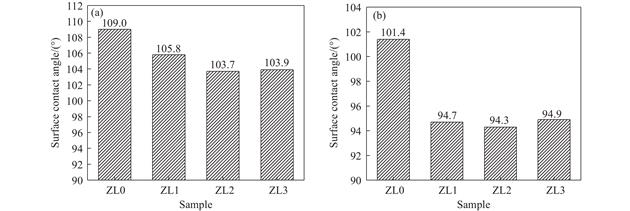| 改性钢渣/橡胶复合材料导热性能及耐久性研究 |
| |
| 引用本文: | 赵令, 程峥明, 郑伟成, 王同宾, 刘自民, 范威威, 张浩, 龙红明. 改性钢渣/橡胶复合材料导热性能及耐久性研究[J]. 工程科学学报, 2023, 45(5): 765-773. DOI: 10.13374/j.issn2095-9389.2022.03.19.003 |
| |
| 作者姓名: | 赵令 程峥明 郑伟成 王同宾 刘自民 范威威 张浩 龙红明 |
| |
| 作者单位: | 1.安徽工业大学冶金工程学院,马鞍山 243032;2.首钢京唐钢铁联合有限责任公司,唐山 063200;3.马鞍山钢铁股份有限公司,马鞍山 243003;4.冶金减排与资源综合利用教育部重点实验室,马鞍山 243002;5.安徽工业大学建筑工程学院,马鞍山 243032 |
| |
| 基金项目: | 国家自然科学基金资助面上项目(52174290);安徽高校协同创新项目(GXXT-2020-072);中国博士后科学基金资助项目(2017M612051) |
| |
| 摘 要: | 
利用自制钢渣助磨改性剂处理热闷渣、电炉渣与风淬渣,将改性后的钢渣微粉与炭黑、橡胶基体等复合形成改性钢渣/橡胶复合材料。采用导热系数仪,测定三种改性钢渣/橡胶复合材料热氧老化1、3、5、7、9、11 d的导热系数;根据Young’s与Flory方程计算出三种改性钢渣/橡胶复合材料热氧老化前后的接触角θ与交联密度;采用热重分析仪(TGA)、场发射扫描电镜(SEM)进行热氧老化前后分析。未热氧老化时,在三种改性钢渣/橡胶复合材料中改性电炉钢渣/橡胶复合材料的导热系数最低,为0.187 W·m−1·K−1,是因为改性电炉渣粒中位径(d50)最小,即3.49 μm,形成更致密的胶裹渣结构,不易形成导热通路,使其导热系数降低。
热氧老化时,破坏胶裹渣结构,改性电炉渣/橡胶复合材料形成的孔隙大,分散性最好,降低界面热阻,更易形成导热通路,使其导热系数最高。热氧老化后,橡胶复合材料表面粗糙度变大且存在较长裂纹与较深孔洞,导致橡胶复合材料吸水性增加,接触角下降。由于改性热闷渣的粒径最大,在热作用下氧气更容易进入橡胶复合材料中与橡胶分子链(双键)发生反应生成自由基,增加分子量,提高交联密度;由于改性风淬渣的碱度最高,为3.3,不利于硫化过程,更易形成的不稳定碳层,使二次燃烧更加充分,导致交联密度变小,在800 ℃时,热氧老化后,改性风淬渣/橡胶复合材料残余物炭渣质量分数仅为1.02%,耐久性最差。

|
| 关 键 词: | 改性钢渣 橡胶 热氧老化 导热系数 交联密度 |
| 收稿时间: | 2022-03-19 |
|
| 点击此处可从《工程科学学报》浏览原始摘要信息 |
|
点击此处可从《工程科学学报》下载免费的PDF全文 |
|



